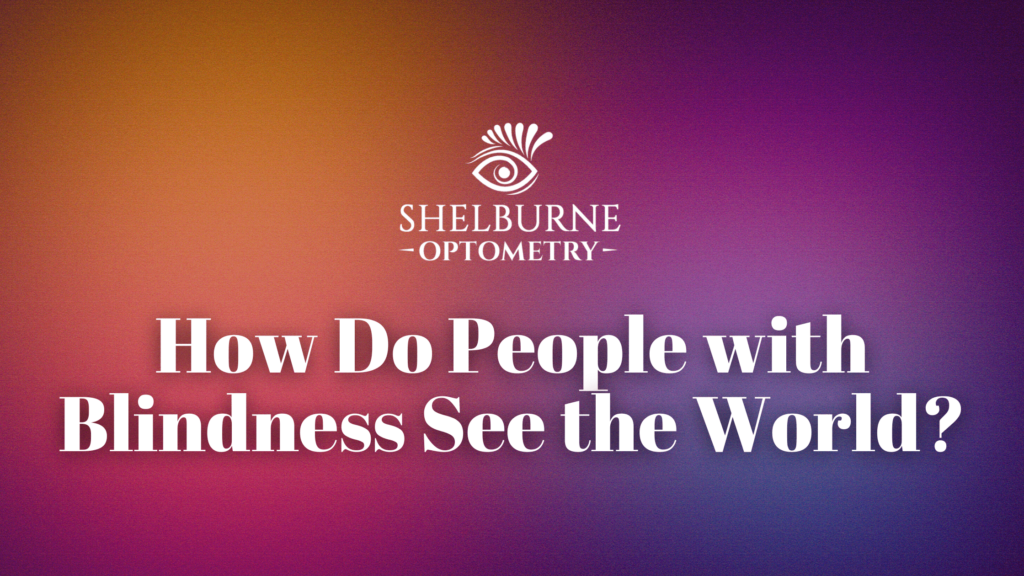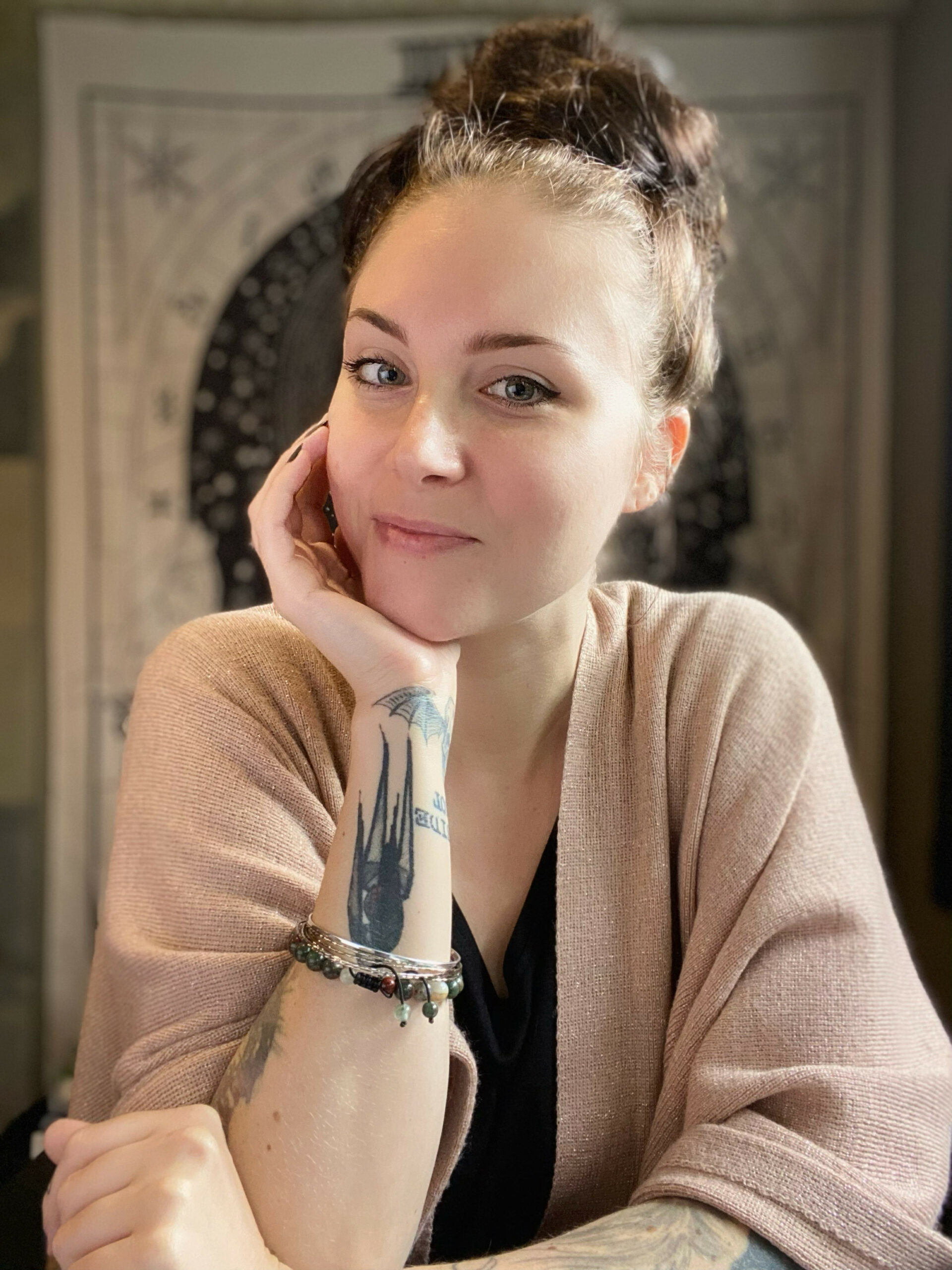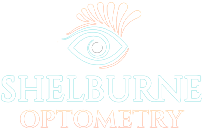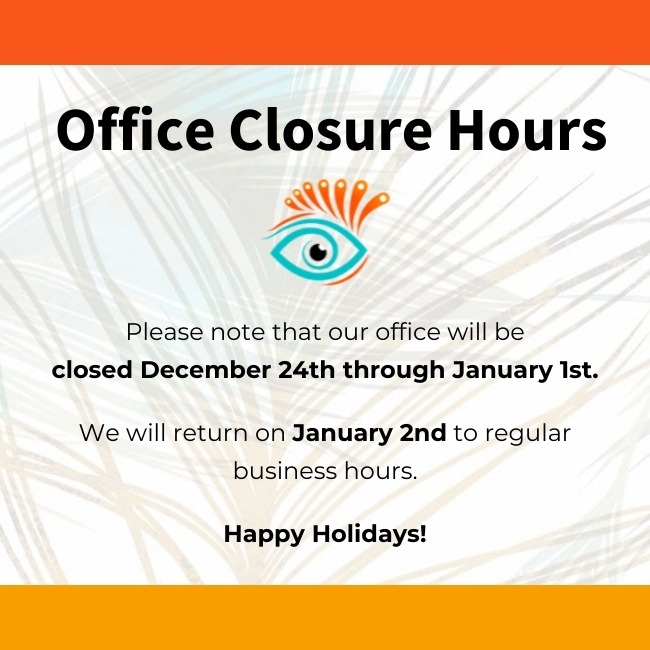When we think of Blindness, we often think of complete vision loss: no awareness of space, colour or movement, requiring physical aids to navigate the world. In reality, there are varying degrees of blindness, and complete blindness (inability to detect any sense of light) is actually considered quite rare. Many people with blindness actually have some small amount of vision, allowing them to see varying shades of light, or even see things up-close.
In Canada, a person is considered legally blind if their best vision is measured as 20/200. This means that they can see something clearly at 20 feet away that someone with clear vision can see at 200 feet away. There are also peripheral vision tests (such as a Visual Field Test involving pressing a button when a peripheral flash of light is seen) that can determine if someone should be considered legally blind. This diagnosis affects a person’s ability to obtain a driver’s licence, among other things.
Colour Blindness
Colour Vision Deficiency, also known as Colour Blindness (which is a bit of a misnomer), is a naturally occurring condition that some people are born with. There are 3 types: protanopia (inability to perceive red light), deuteranopia (inability to perceive green light), and tritanopia (inability to perceive blue light). Some people even experience a combination of 2 types, such as both protanopia (red) and deuteranopia (green). There are even some people who don’t experience colour at all (monochromacy).
Colour blindness is most commonly inherited from a parent (genetic), but can also occur as a side effect of many medical and ocular conditions. It can even be caused simply by ageing, or taking certain medications or drugs.
Colour blindness affects men more frequently than women. It is estimated that about 1 in 12 men experience colour blindness to some degree from birth, while only 1 in about 200 women do. This is because the genetics most associated with colour blindness are on the X chromosome. (If this seems unfair, feel free to read my post Eye of the Tigress: Vision Health for Women to learn all about the epic bag of ocular tricks we get to play with.)
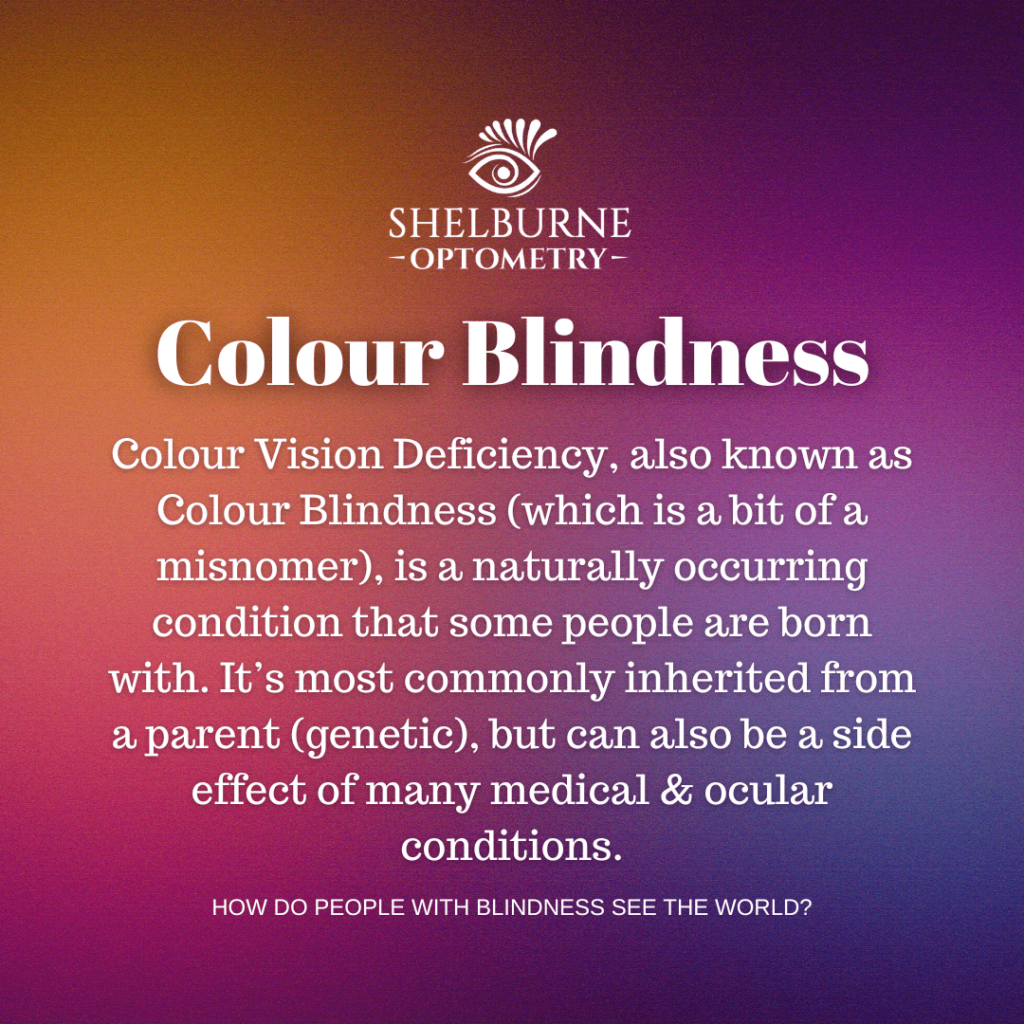
What Causes Blindness?
There are a number of situations, factors and conditions that lead to partial or complete blindness.
Eye diseases that can lead to blindness include:
- Age-Related Macular Degeneration (AMD; a disease affecting the central vision of the macula)
- Cancer (such as Retinoblastoma or orbital tumours)
- Diabetic Retinopathy (a side effect of Diabetes)
- Cataracts (clouding of the lens)
- Glaucoma (damage to the optic nerve caused by too much pressure in the eye)
- Hypertensive Retinopathy (caused by untreated high blood pressure)
- Retinal Detachment (just as it sounds, complete detachment of the retina)
- Retinitis Pigmentosa (a group of rare eye diseases affecting the retina)
- Stroke (if blood flow to the brain areas affecting vision are blocked
- Xerophthalmia (a group of eye symptoms created by Vitamin A deficiency)
- and more.
Some people are diagnosed blind from birth. Causes for this include:
- Anophthalmos (a baby born without eyes)
- Coloboma (missing eye tissue)
- Congenital Cataract (babies born with a clouded lens or lenses)
- Cortical Visual Impairment (CVI; a disorder developed from damage to the parts of the brain that process vision)
- Infantile Glaucoma (optic nerve damage)
- Microphthalmos (a rare disorder in which one or both eyes develop abnormally small)
- Ophthalmia Neonatorum (a bacterial infection passed from mother to child during birth)
- Retinopathy of Prematurity (a vascular disease that affects development of the retina)
- and more.
Other factors that can lead to partial or total blindness include:
- Accidents (including vehicular, fireworks, or other projectiles, such as champagne corks)
- Chemical burns
- Exposure to toxins and chemicals
- Fighting
- Smoking
- Sports
- Work-related accidents such as welding flashes and falls
- and more.
There are a number of factors contributing to the estimated 40+ million cases of blindness in the world today. But, interestingly, only about 10-15% of cases are estimated to have absolutely no vision at all (including no sense of light).
Are blind people missing out? Or do they just experience the world differently? In the early 1800s, a French boy who leaned more to the latter opinion, changed everything.
The Secret Language of Braille
Louis Braille was born in 1809 near Paris, France. He was blinded at the young age of three, following an accident with one of his father’s leather-working tools that slipped and punctured his right eye. Shortly after, sympathetic ophthalmia (inflammation to the uveal tract caused by trauma in the opposite eye) set in to his left eye and he was left totally blind.
At the age of ten, Braille received a scholarship to the National Institute for Blind Children in Paris. While there, he became fascinated with the work of Charles Barbier, a former soldier in Napoleon Bonaparte’s French army. Barbier had witnessed many of his fellow soldiers killed during night attacks while using lamps to read military communications. This inspired him to create what he referred to as “night writing”: a system of 12 raised dots that represented letters and phonetic sounds, that allowed soldiers on the field to read combat messages safely.
Some sources indicate Braille was only eleven years old when he first began adapting Barbier’s system. Some indicate he spent the next nine years developing and perfecting it, also indicating he was fifteen when he first presented it as a complete alphabet. He had adapted Barbier’s 12-dot system to include only 6 dots per character, meaning an entire character could be read with a single fingertip (something that wasn’t previously possible with 12 dots). He also adapted it further to include reading music, as Braille was himself a very talented organist.
Braille published his first book using his 6-dot system in 1829 at the age of twenty. It was titled Method of Writing Words, Music, and Plain Songs by Means of Dots, for Use by the Blind and Arranged for Them. He would later publish a 3-volume edition of a popular history school book.
As an adult, Braille became the first blind professor at Paris’s New School for the Blind, where he taught algebra, geography, grammar and music. There are accounts of him using his small salary to help students buy warm clothing and other needs, and also saved enough money to purchase himself a piano, giving him the freedom to express his love for music whenever he wished.
Braille developed tuberculosis in his mid-twenties and spent the rest of his life in alternating states of health, before passing away in 1852 at the age of forty-three. A century and a half after his death, the writing system that bears his name is considered an essential tool for the blind, and remains virtually unchanged from his original design, with very minor adjustments made over the years. It is available in nearly every language of the world, and there are more than 11,000 braille books published today.
(Side Note: It is widely indicated that braille is, in fact, not a language, but a “tactile code”. I care not. T’was the perfect title for my section and shall remain thus. *haughtily sips coffee*)
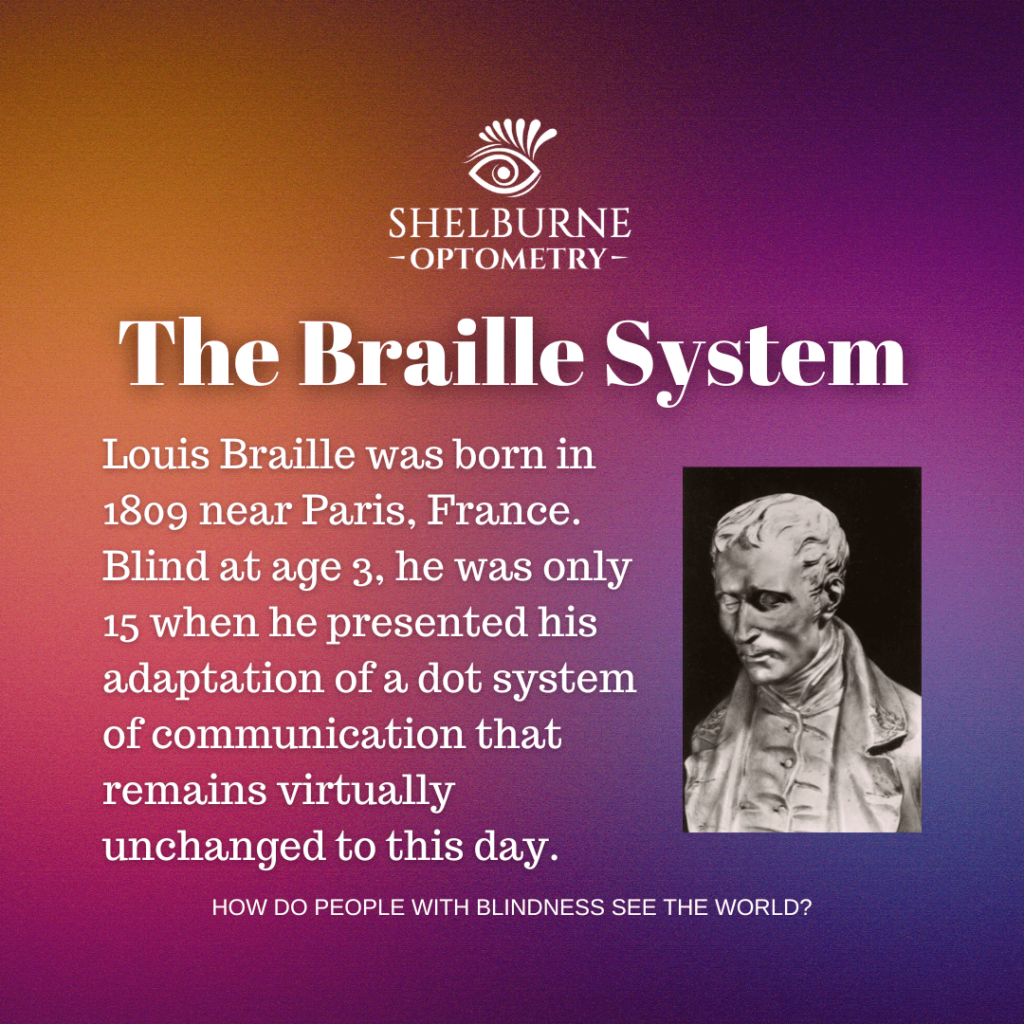
A World of Possibility
There are more options than ever before to make the world more accessible for people with blindness, and a growing understanding that while they may experience the world differently than others, they are not “missing out”; they are having a completely valid human experience of this plane of existence we call home.
For some cases of vision loss, visibility aids such as magnifiers, large-print products, glasses or contacts can offer some improvement. For others, surgical options such as cataracts removal or corneal transplants may be the answer. There are a number of cases where retinal detachment that was caught early has been successfully treated. The world’s wonderful embracing of the Braille system has revolutionised signage, indicators and communication devices, in addition to books and music. There are also aids such as walking sticks, guide animals, and even people who train to accompany blind people and assist them as they desire (as with any condition or disability, it is essential to never assume what sort of “help” a person may or may not require).
Have you ever used a crosswalk and heard a chirping sound? It allows visually impaired folks to know when it is safe for them to cross the street. There are even some that trigger a voice that says, “Walk sign is on.” (Funny story: the one near my home sounds more like, “What’s going on?” and I pray that any blind folks using it hear it correctly and don’t wonder at the question themselves like we did.)
Other visual aids include screen-readers, and the more recently developed “smart glasses” that use AI technology to incorporate text to speech (for reading anything from emails to signage), visual descriptions of surroundings, and even a “Find Object” feature. There are also glasses that allow people with colour blindness to see the world in full colour (online videos of this are very heart-warming). The meteoric rise of audiobooks broadened the library of many blind people exponentially, especially considering only about 1% of published works are actually transcribed into braille. Bone Conduction Headphones translate sound to the wearer through the bones in their skull, allowing them to still hear ambient sound around them such as voices or traffic, which is kind of wicked cool if you ask me.
As we continue to experience advances and breakthroughs, there’s no telling where we may be a decade from now when it comes to visual assistive technology.
Final Thoughts
As you can see, there are many more options than ever before for those who are born with or develop visual impairments or blindness. It is not a sentence to darkness, or loneliness. There is much we can learn from those who see the world differently, particularly about patience and living with the full potential of our senses and spectrum of our awareness. As world-renowned author and activist Helen Keller said, “The only thing worse than being blind is having sight but no vision.”
Wishing you all the best in wherever your path takes you today,
Sydney Gallant, CCOA


